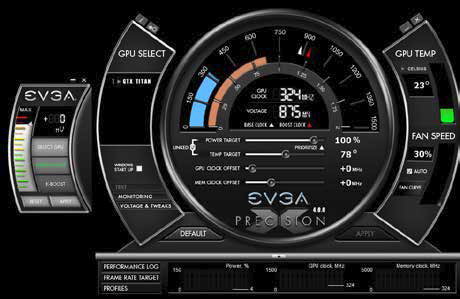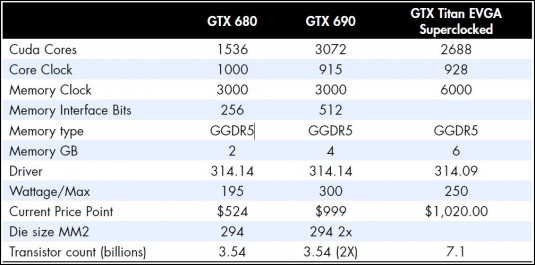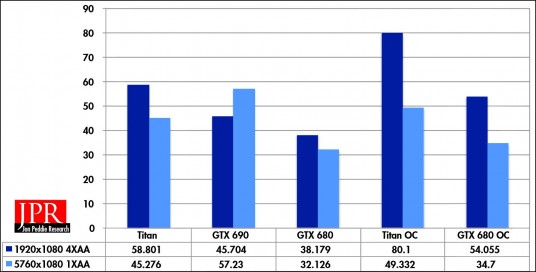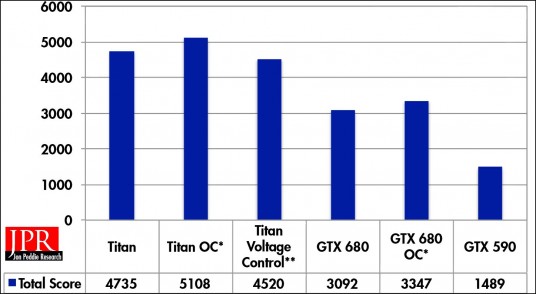The stock edition is a great board, but the overclocked versions rate two thumbs up from our reviewers.
By Harrison Garovi and Robert Dow
Jon Peddie Research
The word “intimidating” still only applies to one graphics card, the MSI Mars II, which was basically two GTX 580 cards mashed together. In fact, we are still looking for a tower big enough to house ours. As far as graphics processing units go, the GK110 is about as intimidating as they come. With a die size of 512 mm, it is 77% larger than the 294-mm GK104 with double the transistor count. The GK104, the previous Nvidia flagship processor, contains 3.54 billion transistors, while the GK110 comes in with 7.08 billion—that is a transistor for every man, woman, and child on the planet with a few million to spare just in case you lose yours.

The early production runs of Titan are relatively low with about 10,000 to 20,000 being built and sold. This accounts for the stories of the retailers not being able to keep them on the shelves despite its $999 price tag. However, Nvidia tells us Titan should not be considered a boutique item and should be readily available from Nvidia partners in the upcoming months.
One of those OEM partners is EVGA, and EVGA is offering three different Titan class boards: the Titan Superclocked Signature, the Titan Superclocked, and the Titan stock. In this report we are taking a look at the Titan Superclocked, which we compared to the GTX 680 and GTX 690. The general comparison of the three AIBs is shown in the table.
Precision X
Accompanying EVGA’s new line of Titan add-in boards is its next generation of exclusive overclocking software, Precision X 4.0. Much more than just an overclocking interface, Precision X is an entire control panel for your Titan or other GeForce card. You can control the core clock, memory clock, fan, voltage, temperature, and monitor and all of the above while in a game. Precision is an amazing tool and shouldn’t be discounted, especially because the Kepler processors really respond to overclocking. We overclocked the Titan and GFX 680 just 10% and saw a 1:1 ratio of return in frames per second (FPS) performance and more, which in some cases is rare.

EVGA took Precision X and was able to expand the toolbox when running the Titan. The new Precision X 4.0 with Titan comes with a temperature and power slider (voltage) that allows you to target both, and with a priority control that allows the temperature to override the power or vice versa, depending on your desired performance.
If you set a temperature as the priority target, the card will drop the clock and voltage when it hits your maximum desired temperature. There is also a voltage and tweaks option exclusive to Titan that allows you to turn up the voltage by another 40 millivolts.

The fan control is an important option in Precision. We cranked up the fan controls by 50% when overclocking the GTX cards, which allowed us to overclock the cards by 10% but actually keep the top temperature 2 degrees Celsius below the top temperature when running the card at normal speeds. Now, you will find a 4-decibel increase in background noise, and we found if we turn the clock up to 60% the fan noise starts to become annoying during gameplay. But if you are one to put on earphones and get lost in the game, you will most likely not give it a second thought.
We tested the cards with two synthetic benchmarks, 3DMark 11 and the new 3D Mark Firestrike, as well as Crysis 3 and Far Cry 3. We ran the games in 1080 4X AA as well as 5760 x 1080 resolution. These are the top of the line enthusiasts’ cards and will mostly find their way in the hands of gamers who prefer surround and/or have higher resolution displays.
The 3DMark 11 was run in Extreme mode, as was 3DMark Firestrike. Firestrike, the new benchmark from Futuremark, renders in 2560 x 1440 with 16X anisotropy filtering and 10X tessellation detail.

For the overclocking parameters, we overclocked each card by 10% of the core clock, 10% of the memory clock, 6% of the voltage, and turned the fan up 50%. We were able to see a measurable FPS gain with the Kepler family, and when we turned up the fan, the temperature of the GPU actually remained slightly cooler. There is no doubt there is more headroom to turn up the clocks even higher.
We usually only expect to see a modest frame rate gain, maybe 2 or 3 FPS but Kepler overclocks very well and we saw a 9% to 12% gain in 3DMark 11 and 8% to 9% performance boost in Firestrike. In Crysis 3, the overclocking performance was off the charts. We had to run the tests a few hundred times to make sure the numbers we were seeing were accurate. We suspect the Nvidia drivers for Crysis 3 must be tuned just right to get such solid performance in 1920 x 1080.

In addition to overclocking Titan, we also played with the voltage control. We have a 1200W power supply in our test bed, but if you haven’t upgraded your power supply in your PC and you are running an 850W (EVGA’s minimum power supply requirement), you might think about turning down the voltage. We turned down the voltage setting 15%, which in turn adjusted the max temperature to 73 degrees Celsius. By turning down the voltage 15%, we saw a 5.3% performance drop from the default settings—not too bad.

How did the Titan do?
The Titan is a powerful card performing on par with the GTX 690 which is running multiple GPUs, and physically they are almost indistinguishable aside from the “Titan” imprint on top of the AIB. The cast aluminum and magnesium alloy was beautiful on the GTX 690 and is just as impressive on the Titan. Considering as powerful as the card is, it is super quiet, almost immeasurable compared to the rest of the PC unless you decide to turn up the fan. But given the cooling capabilities of the Titan, users would only need to increase the fan speed if they are overclocking.
The Titan is equipped with 2-DVI ports, 1 DisplayLink as well as a DVI. The Nvidia drivers as easy to use, and the setup for a multi-monitor configuration is no problem at all.
The Titan is an impressive piece of engineering and is by far the most powerful single GPU card around. The GTX 690 can outperform the Titan, and the price point of the GTX 690 has been dropping, making it slightly more affordable for now. The Precision 4.0 software that EVGA has tuned for the Titan Precision X 4.0 and all of its line of GeForce cards is a powerful tool and makes playing with the options on the card almost as much fun as dealing with the Ceph.





